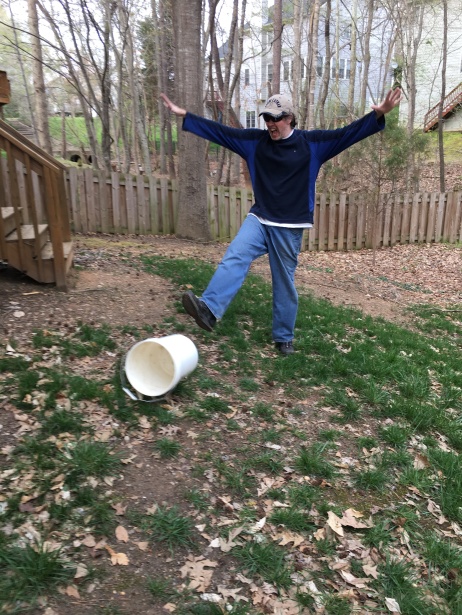An injury — known colloquially as an “ouchy” or “oopsy” or “ass-bust” — is an unfortunate event can really mess up your life. Injuries are known to happen to hikers.

Injuries come in two types…minor and major.
Minor injuries are small, often chronic, and mostly aggravating. They seldom keep you from doing what you like to do, but they make it more difficult and less enjoyable. Minor injuries are pretty much inevitable and people who participate in active sports of any kind deal with them as a matter of course. Hiking is certainly no exception. These types of injuries cannot be prevented entirely; they just come with the landscape, so to speak. But they can be reduced in scope, both in terms of their frequency and severity.
Major Injuries are not small; usually they are traumatic in nature and the result of some violent or unfortunate episode, such as a fall or smashing ones head on a low hanging branch (to mention two of Brian’s commonly indulged in methods.) Major injuries do more than just aggravate; they prevent you from doing what you want to do, and in some cases can have long lasting and potentially life altering consequences. You want to avoid major injuries as much as possible.
You cannot always prepare for or avoid injuries, but you can reduce the risk of their occurring substantially through:
- Preparation
- Conditioning
- Exercising caution
- Not doing anything blatantly stupid
Preparation. Don’t be that guy who gets caught under a boulder and is forced to saw his arm off with a sharpened popsicle stick. Know the trail, the conditions you are likely to encounter, what obstacles you will have to overcome and what gear and or skills you will need to overcome them. If you know the trail you can avoid many situations that could result in injuries. Be prepared to treat minor aggravating injuries immediately before they get worse, and if the worst happens, have a plan ready and know what the best option is.
Conditioning. The stronger and fitter you are, the less prone to injuries. One thing many people neglect when training is flexibility. Don’t be one of those people; today’s stiff joint or back is tomorrow’s strain or sprain.
Exercising Caution. In addition to being very painful, major injuries are not easily treated by people without medical experience…nor is an ambulance going to show up in fifteen minutes in the backcountry. Thus, it’s a good idea to avoid situations where one is forced to manage major injuries. Or another way of saying it is: the best way to manage major injuries is not to have them.
Exercising caution does not mean shying away from all risk. It means assessing the situation, evaluating the options, making good decisions and avoiding the obviously bad ones. Many times we have turned back because the trail ahead didn’t look safe. Many other times, we wished we HAD turned back. Bad weather, exposed areas, badly eroded or washed out trails, vertical trail grades and slippery or unstable footing are all things to avoid if possible, and exercise extreme caution with when you can’t.
One last note about injuries…our experience is that many bad falls are the result of someone being distracted and not paying attention to the trail. This might have been the result of talking to someone else, or being distracted by a troublesome piece of gear or something happening off in a tree. Brian, a head down hiker, often is fixated on the trail itself and forgets to look up for approaching branches.
Be aware. Take stock of the situation, focus on the moment and don’t get distracted, especially in rough terrain. Pay attention and you might just prevent a fall.
Not Doing Anything Blatantly Stupid. Not engaging in a no-brainer might seem like a no-brainer but we have seen people do any number of shockingly stupid things that could easily get them killed. Disregarding warning signs, horsing around near cliff faces or waterfalls, or simply going too far down the trail without proper equipment or enough water are all bad ideas. In our years of hiking we have seen it all. To err is human…but don’t invite it with bad judgement. Take yourself and the outdoors seriously.
Here’s some other things that will help reduce injuries…
Reducing pack weight. Your knees and back will thank you.
The Right Shoes. A bad pair of shoes is almost certainly the most significant cause of minor hiker injuries such as blisters, ankle and heel problems. Also consider orthotic support inserts.
Prompt Management of the Injury. When something starts to hurt, the time to deal with it is immediately — not at the next rest break or when you get to camp or once you get back to the car, etc. This is especially true of blisters. Stop, take a break, asses the situation. Put on a bandage or moleskin; change into a dry pair of socks; stretch the joint out. Toughing out an injury is sometimes necessary but always attempt treatment first.
Ice. Not walking on it, mind you…making use of it. If and when its available. If its not, a cold stream is almost as effective.
Knowing When to Stop. Being a hiker means being your own personal trainer; you have to know when to push yourself forward through pain and discomfort and fatigue, and when to slow down or stop. Pushing yourself forward is necessary, but pushing yourself into an injury accomplishes nothing. Learn to monitor and manage pain and fatigue, but never ignore them.
The bottom line with minor injuries is…they happen. So concentrate on making them happen less and then deal effectively with those that do.
And the bottom line with major injuries is that they can’t be managed easily, so avoid them every way you can.